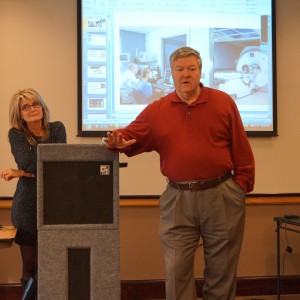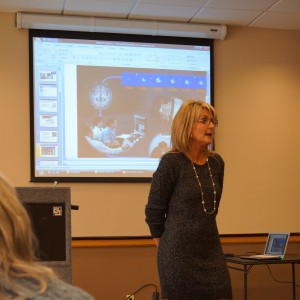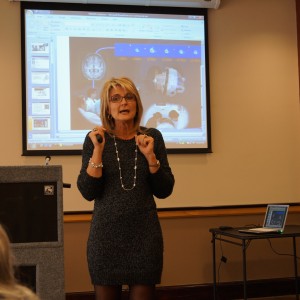During the past year, it became apparent as we spoke to Congressional Legislative Assistants for Healthcare that we needed more facts about Essential Tremor – if we were to adequately present our case. A doctor, who has ET and is active in the Columbia Support Group, suggested to me that we needed more epidemiology on ET. Accordingly, I contacted Dr. Elan Louis at Columbia University. He is both a neurologist and an epidemiologist. The result of our conversation was that Dr. Louis agreed, and he did this study. I am very thankful to him.
Peter Muller
How Many People in the USA Have Essential Tremor? Deriving a Population Estimate Based on Epidemiological Data
Elan D. Louis 1,2,3,4* & Ruth Ottman 1,3,4,5
1GH Sergievsky Center, College of Physicians and Surgeons, Columbia University, New York, NY, USA, 2 Taub Institute for Research on Alzheimer’s Disease and the Aging Brain, College of Physicians and Surgeons, Columbia University, New York, NY, USA, 3 Department of Neurology, College of Physicians and Surgeons, Columbia University, New York, NY, USA, 4 Department of Epidemiology, Mailman School of Public Health, Columbia University, New York, NY, USA, 5 Division
of Epidemiology, New York State Psychiatric Institute, New York, NY, USA
Abstract
Background: Essential tremor (ET) is often reported to be among the most prevalent movement disorders, yet the precise number of cases in the USA is not known. The goal of the current analyses was to use published data from epidemiological studies to derive an estimate of the number of people currently residing in the USA who have ET.
Methods: A PubMed search was conducted to identify population-based prevalence studies of ET. The methodology of 34 identified studies was assessed. Then the three most methodologically rigorous studies were selected, and age-specific prevalence data were abstracted. US census data from 2012 were used to determine the population in the USA by 10-year age categories.
Results: Using data from three studies, estimates of the number of ET cases (2012) ranged from 6.38 to 7.63 million (mean57.01 million). This corresponds to approximately 2.2% of the US population.
Discussion: Knowing the number of ET cases in the USA is important in terms of estimating the medical burden on communities and society, and providing an objective metric on which to base health resource planning.
Keywords: Essential tremor, population, epidemiology, prevalence, public health
Citation: Louis ED, Ottman R. How many people in the USA have essential tremor? Deriving a population estimate based on epidemiological data. Tremor Other Hyperkinet Mov. 2014; 4. doi: 10.7916/D8TT4P4B
*To whom correspondence should be addressed. E-mail: EDL2@columbia.edu
Editor: Julian Benito-Leon, Hospital ‘‘12 de Octubre’’, Spain
Received: June 19, 2014 Accepted: July 21, 2014 Published: August 13, 2014
Copyright: ©2014 Louis et al. This is an open-access article distributed under the terms of the Creative Commons Attribution–Noncommercial–No Derivatives License, which permits the user to copy, distribute, and transmit the work provided that the original author(s) and source are credited; that no commercial use is made of the work; and that the work is not altered or transformed.
Funding: None.
Financial Disclosures: Dr. Louis has received research support from the National Institutes of Health: NINDS #R01 NS042859 (principal investigator), NINDS #R01 NS39422 (principal investigator), NINDS #R01 NS086736 (principal investigator), NINDS #R01 NS073872 (principal investigator), NINDS #R01 NS085136 (principal investigator), NINDS #T32 NS07153-24 (principal investigator), NINDS #R21 NS077094 (co-Investigator), NINDS #R01 NS36630 (co-Investigator), NIEHS P30 ES09089 (co-investigator), and CTSA grant number UL1 RR024156. He has also received support from the Parkinson’s Disease Foundation, the Arlene Bronstein Essential Tremor Research Fund (Columbia University), and the Claire O9Neil Essential Tremor Research Fund (Columbia University). Dr. Ottman serves on the scientific advisory board for and holds stock options in Trigeminal Solutions, Inc; received funding for travel from the E ´ cole des Hautes Etudes en Sante´ Publique; and received research support from the NIH through #U01 NS077276 (MPI), #U01 NS077367 (MPI), #R01 NS078419 (PI), P50 HG007257 (Co-I), #NIH R01 NS073872 (Co-I), and #R01 AG041797 (Co-I).
Conflict of Interest: The authors report no conflict of interest.
Introduction
Essential tremor (ET) is often reported to be among the most prevalent movement disorders, and it is the most common cause of abnormal tremor in humans.1 The incidence of ET rises with age.2,3 Furthermore, the reported increased risk of mortality associated with ET is modest,4 and, therefore, incident cases accumulate with time,
contributing to the often-observed age-associated rise in disease prevalence.1,5,6
Despite its reportedly high prevalence, the precise number of ET cases in the USA is not known. One often-cited paper, published in 1995, estimated that 13.5 million Americans had ET,7 and given the growth in the US population over the past 19 years, one would expect that an even larger number of Americans now have ET. However, the methods used to derive the estimate of 13.5 million are not completely transparent.7 Websites for disease-specific organizations, such as the International Essential Tremor Foundation, report that there are an estimated 10 million Americans with ET. Again, the basis for this
estimate is not clear.
Knowing the number of ET cases is important for estimating the medical burden on communities and society, and providing an objective metric on which to base health resource planning. The goal of the current analyses was to use published data from epidemiological studies to derive an estimate of the number of people currently residing
in the USA who have ET.
Table 1. Prevalence data for ET (per 100) by Age Category in Four Selected Studies
| Age Category (Years)1 |
Dogu et al.5 (Turkey)
|
Glick et al.18(Israel)
|
Sur et al. 20(Turkey)
|
Seijo-Martinez et al.14 (Spain)
|
| 18-30 |
|
|
0.79
|
|
| 31-40 |
|
|
0.83
|
|
| 40-49 |
2.8
|
|
1.562
|
|
| 50-59 |
3.5
|
|
2.892
|
|
| 60-69 |
5.9
|
|
3.882
|
|
| 65-69 |
|
0.57
|
|
|
| 65-74 |
|
|
|
7.35
|
| 70-79 |
6.5
|
0.72
|
|
|
| 75-84 |
|
|
|
9.92
|
| 71 and older |
|
|
9.34
|
|
| 80 and older |
8.7
|
1.47
|
|
|
| 85 and older |
|
|
|
11.24
|
Abbreviaton: ET, Essential Tremor
1 Several studies used different age cut points.
2 Actual age categories were 41-50, 51-60, and 61-70 years.
Methods
A PubMed search was conducted in May 2014 in order to identify published population-based prevalence studies of ET. The search terms were ‘‘prevalence’’, ‘‘incidence’’, ‘‘epidemiology’’, ‘‘population’’, and ‘‘essential tremor’’, and all full-length English language papers were identified. One full-length paper in Chinese was excluded.8 The search yielded 34 population-based prevalence studies.1,9–14 The methodology of each identified study was assessed, and methodologically more rigorous studies were selected for further review. The methodological issues of greatest importance were as follows: 1) all subjects in the sample received an in-person neurological examination
or the study provided information to indicate that the sensitivity of the screening questionnaire used during the first phase of case ascertainment was high, 2) neurologists assigned the ET diagnoses, 3) the study used diagnostic criteria that sufficiently separate ET from other entities such as enhanced physiological tremor, which are common in the population, and 4) the study provided separate age-specific estimates of prevalence. Age-specific prevalence data from the selected studies were then abstracted. US census data from 2012 were used to derive counts of the population in the USA by 10-year age categories.15
Results
The search identified 34 population-based prevalence studies, including 28 reviewed by Louis et al. in 2010 and six published after that point.1,9–14 Of these 34 studies, 16 were identified in which: 1) the method of case ascertainment involved either neurological examination of all subjects in a population sample or administration of a screening questionnaire followed by neurological examination, and the sensitivity of the screen was provided, and 2) estimates of prevalence were provided within age strata.5,6,11,12,14,16–26 Of these 16,5,6,11,12,14,16–26 12 used diagnostic criteria for ET that are not ideally suited to epidemiological investigations (e.g., the Consensus Statement of the Movement Disorder Society27) because they do not sufficiently separate ET from other entities such as enhanced physiological tremor, and/or used non-neurologists to assign ET diagnoses, which is not optimal. Four studies remained; these were conducted in Israel,18 Turkey,5,20 and Spain.14 The age-specific prevalence of ET is displayed for each of these four studies (Table 1).5,14,18,20 One of these studies18 focused exclusively on a specific ethnic group (Arab villagers in Northern Israel) and the prevalence estimates were one order of magnitude lower than those reported in the other three studies;5,14,20 hence it was excluded, leaving three remaining studies.5,14,20
Prevalence data from each of the three remaining studies were used, in conjunction with 2012 US Census data, to estimate the number of individuals in the USA with ET in 2012. First, using data from the study in Istanbul, Turkey,20 one would estimate that 6.38–6.78 million individuals in the USA have ET. This estimate used age-specific ET prevalence data from Istanbul for ages 18 and older. For individuals who were younger than age 18, we used incidence data for ET from Rochester, Minnesota,3 which indicated that 14 of 266 (5.3%) ET cases arise prior to age 20 years. Using these data, we made two alternative assumptions. The first assumption was that none of the ET cases whose tremor began prior to age 20 was still younger than 20; the second assumption was that all of these ET cases were still younger than 20. The alternative assumptions resulted in two different estimates, 6.38 and 6.78 million for assumptions 1 and 2, respectively. Second, using data from the study in Mersin, Turkey,5 we estimated that 7.23–7.63 million individuals in the USA have ET. To derive this estimate, we used the published age-specific estimates from Mersin for ages 40 or older. To include younger individuals, we used data from the study in Istanbul20 for individuals aged 18–40, and data from Rochester, Minnesota3 for individuals aged 18 and younger. We made the same two alternative assumptions described above about the current ages of childhood onset cases. Third, using data from the study in Spain,14 we estimated that 6.75–7.15 million individuals in the USA have ET. This estimate was based on published age-specific estimates from Spain for individuals aged 65 or older. For younger individuals, we used data from the study in Istanbul20 for those aged 18–65 and data from Rochester, Minnesota3 for those aged 18 or younger. Again, we used the same two alternative assumptions as in the other studies about the current ages of childhood onset cases. For all three studies, the estimates of the number of individuals with ET in the USA (2012) range from 6.38–7.63 million (mean57.01 million).
Discussion
In the current study, we estimated that approximately 7 million people in the USA have ET. This represents 2.2% of the US population. By comparison, the number of people with Parkinson’s disease, another tremor disorder, is estimated at 0.5–1 million, or about 0.15–0.3% of the population.
ET is one of the most common neurological diseases, and with 7 million people in the country affected, it is expected to result in considerable health care expenditures. Its effects on loss of work productivity have not been determined on a broad societal level. One study reported that 25% of ET cases were forced to change jobs or take early retirement because of tremor;28 however, the ET cases were recruited to a specialty care center rather than from the population, so it is difficult to extrapolate these data to cases in the general population, who often have tremor that is milder than that seen in clinic patients.29,30 No studies have attempted to estimate the magnitude of health care expenditures associated with ET, yet this is an issue of great import.
There are a number of important caveats to consider. All of the three selected epidemiological studies had design features that were most likely to have optimally captured ET cases and assigned valid diagnoses; however, they were carried outside of the USA.5,14,20 Despite this, age-specific prevalence estimates across the same age categories in these three studies were largely in agreement with one another, making it likely that they are a reasonable approximation of the true prevalence of ET and a reasonable starting point for approximating the prevalence of ET in the USA. In addition, there is currently no alternative but to use these data. The second issue is that data on the prevalence of ET in children were derived from a single study of the incidence rather than the prevalence of ET. Hence, the estimates we used made two opposing assumptions to provide the reader with both the most and the least conservative estimates. Regardless, the incidence and prevalence of ET are very low in children, and the two diametrically opposed assumptions resulted in estimates that were in the same general range.
In summary, the current study estimates that 7.01 million individuals in the USA have ET. This corresponds to approximately 2.2% of the US population. Knowing the number of ET cases is important for estimating the medical burden on communities and society, and providing an objective metric on which to base health resource planning.
Acknowledgment
The authors wish to acknowledge Nicole Schupf, PhD, DrPH, for her critical reading of the manuscript and constructive suggestions.
References
1. Louis ED, Ferreira JJ. How common is the most common adult movement disorder? Update on the worldwide prevalence of essential tremor. Mov Disord 2010;25:534–541, doi: http://dx.doi.org/10.1002/mds.22838.
2. Benito-Leon J, Bermejo-Pareja F, Louis ED. Incidence of essential tremor in three elderly populations of central Spain. Neurology 2005;64:1721–1725, doi: http://dx.doi.org/10.1212/01.WNL.0000161852.70374.01.
3. Rajput AH, Offord KP, Beard CM, Kurland LT. Essential tremor in Rochester, Minnesota: A 45-year study. J Neurol Neurosurg Psychiatry 1984;47:466–470, doi: http://dx.doi.org/10.1136/jnnp.47.5.466.
4. Louis ED, Benito-Leon J, Ottman R, Bermejo-Pareja F. A population based study of mortality in essential tremor. Neurology 2007;69:1982–1989, doi: http://dx.doi.org/10.1212/01.wnl.0000279339.87987.d7.
5. Dogu O, Sevim S, Camdeviren H, et al. Prevalence of essential tremor: Door-to-door neurologic exams in Mersin Province, Turkey. Neurology 2003;61:1804–1806, doi: http://dx.doi.org/10.1212/01.WNL.0000099075.19951.8C.
6. Benito-Leon J, Bermejo-Pareja F, Morales JM, Vega S, Molina JA. Prevalence of essential tremor in three elderly populations of central Spain. Mov Disord 2003;18:389–394, doi: http://dx.doi.org/10.1002/mds.10376.
7. Lundervold DA, Poppen R. Biobehavioral rehabilitation for older adults with essential tremor. Gerontologist 1995;35:556–559, doi: http://dx.doi.org/10. 1093/geront/35.4.556.
8. Liu Y, Zhang XY, Tang YZ, et al. [Investigation on prevalence rate of essential tremor in population aged 55 years old and above in Kashkar, between 2008 and 2009]. Zhonghua yi xue za zhi 2011;91:1067–1069.
9. Barbosa MT, Caramelli P, Cunningham MC, Maia DP, Lima-Costa MF, Cardoso F. Prevalence and clinical classification of tremor in elderly—A community-based survey in Brazil. Mov Disord 2013;28:640–646, doi: http://dx.doi.org/10.1002/mds.25355.
10. Ozel L, Demir R, Ozdemir G, et al. Investigation of the prevalence of essential tremor in individuals aged 18–60 in Erzurum. Acta Neurologica Belgica 2013;113:127–131, doi: http://dx.doi.org/10.1007/s13760-012-0147-5.
11. Aharon-Peretz J, Badarny S, Ibrahim R, Gershoni-Baruch R, Hassoun G. Essential tremor prevalence is low in the Druze population in northern Israel. Tremor Other Hyperkinet Mov 2012;2:http://tremorjournal.org/article/view/81.
12. Okubadejo NU, Bankole IA, Ojo OO, Ojini FI, Danesi MA. Prevalence of essential tremor in urban Lagos, Nigeria: A door-to-door community-based study. BMC Neurol 2012;12:110, doi: http://dx.doi.org/10.1186/1471-2377-12-110.
13. Louis ED, Hafeman D, Parvez F, et al. Prevalence of essential tremor in Araihazar, Bangladesh: A population-based study. Neuroepidemiology 2011;36:71–76, doi: http://dx.doi.org/10.1159/000323389.
14. Seijo-Martinez M, Del Rio MC, Alvarez JR, et al. Prevalence of essential tremor on Arosa Island, Spain: A community-based, door-to-door survey. Tremor Other Hyperkinet Mov 2013;3:http://tremorjournal.org/article/view/192.
15. United States Census Bureau. Current population survey. Annual social and economic supplement, 2012. Internet release data: December 2013. http://www.census.gov/population/age/data/2012comp.html
16. Hornabrook RW, Nagurney JT. Essential tremor in Papua, New Guinea. Brain 1976;99:659–672, doi: http://dx.doi.org/10.1093/brain/99.4.659.
17. Salemi G, Savettieri G, Rocca WA, et al. Prevalence of essential tremor:A door-to-door survey in Terrasini, Sicily. Sicilian Neuro-Epidemiologic Study Group. Neurology 1994;44:61–64, doi: http://dx.doi.org/10.1212/WNL.44.1.61.
18. Glik A, Masarwa M, Abuful A, et al. Essential tremor might be less frequent than Parkinson’s disease in North Israel Arab villages. Mov Disord 2009; 24:119–122, doi: http://dx.doi.org/10.1002/mds.22324.
19. Mancini ML, Stracci F, Tambasco N, Sarchielli P, Rossi A, Calabresi P. Prevalence of essential tremor in the territory of Lake Trasimeno, Italy: Results of a population-based study. Mov Disord 2007;22:540–545, doi: http://dx.doi.org/10.1002/mds.21349.
20. Sur H, Ilhan S, Erdogan H, Ozturk E, Tasdemir M, Boru UT. Prevalence of essential tremor: A door-to-door survey in Sile, Istanbul, Turkey. Parkinsonism Relat Disord 2009;15:101–104, doi: http://dx.doi.org/10.1016/j.parkreldis.2008.03.009.
21. Louis ED, Marder K, Cote L, et al. Differences in the prevalence of essential tremor among elderly African Americans, whites, and Hispanics in northern Manhattan, NY. Arch Neurol 1995;52:1201–1205, doi: http://dx.doi.org/10.1001/archneur.1995.00540360079019.
22. Louis ED, Thawani SP, Andrews HF. Prevalence of essential tremor in a multiethnic, community-based study in northern Manhattan, New York, N.Y. Neuroepidemiology 2009;32:208–214, doi: http://dx.doi.org/10.1159/000195691.
23. Bergareche A, De La Puente E, Lopez De Munain A, et al. Prevalence of essential tremor: A door-to-door survey in Bidasoa, Spain. Neuroepidemiology 2001;20:125–128, doi: http://dx.doi.org/10.1159/000054771.
24. Rautakorpi I, Takala J, Marttila RJ, Sievers K, Rinne UK. Essential tremor in a Finnish population. Acta Neurol Scand 1982;66:58–67, doi: http://dx.doi.org/10.1111/j.1600-0404.1982.tb03129.x.
25. Moghal S, Rajput AH, D9Arcy C, Rajput R. Prevalence of movement disorders in elderly community residents. Neuroepidemiology 1994;13:175–178, doi: http://dx.doi.org/10.1159/000110376.
26. Khatter AS, Kurth MC, Brewer MA, et al. Prevalence of tremor and Parkinson’s disease. Parkinsonism Relat Disord 1996;2:205–208, doi: http://dx.doi.org/10.1016/S1353-8020(96)00027-2.
27. Deuschl G, Bain P, Brin M. Consensus statement of the Movement Disorder Society on Tremor. Ad Hoc Scientific Committee. Mov Disord 1998; 13(Suppl 3):2–23.
28. Bain PG, Findley LJ, Thompson PD, et al. A study of hereditary essential tremor. Brain 1994;117(Pt 4):805–824, doi: http://dx.doi.org/10.1093/brain/117.4.805.
29. Dogu O, Louis ED, Sevim S, Kaleagasi H, Aral M. Clinical characteristics of essential tremor in Mersin, Turkey—A population-based door-to-door study. J Neurol 2005;252:570–574, doi: http://dx.doi.org/10.1007/s00415-005-0700-8.
30. Louis ED, Ford B, Wendt KJ, Cameron G. Clinical characteristics of essential tremor: Data from a community-based study. Mov Disord 1998;13:803–808, doi: http://dx.doi.org/10.1002/mds.870130508.
(PDF Version)



